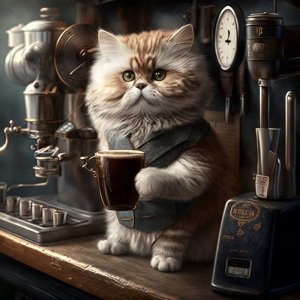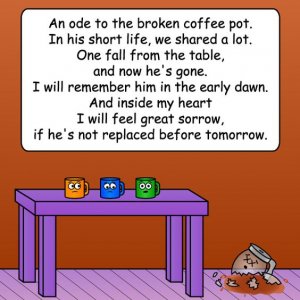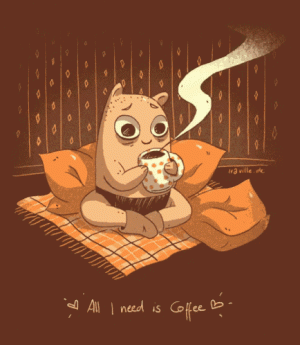You are using an out of date browser. It may not display this or other websites correctly.
You should upgrade or use an alternative browser.
You should upgrade or use an alternative browser.
Welcome To Coffee Corner
- Thread starter Meanderer
- Start date
RadishRose
SF VIP
- Location
- Connecticut, USA
RadishRose
SF VIP
- Location
- Connecticut, USA
OldFeller
Well-known Member
- Location
- Pennsylvania, USA
The Holy Grail of Coffee
The best cup of coffee I ever had was $150.00/lb and came from the defecated mass of an animal. A guy in work brought it in.
Kopi luwak, also known as civet coffee, is a coffee that consists of partially digested coffee cherries, which have been eaten and defecated by the Asian palm civet(Paradoxurus hermaphroditus). The cherries are fermented as they pass through a civet's intestines, and after being defecated with other fecal matter, they are collected. Asian palm civets are increasingly caught in the wild and traded for this purpose.
Kopi luwak is produced mainly on the Indonesian islands of Sumatra, Java, Bali, Sulawesi, and in East Timor. It is also widely gathered in the forest or produced in farms in the islands of the Philippines,[3] where the product is called kape motit in the Cordillera region, kapé alamíd in Tagalog areas, kapé melô or kapé musang in Mindanao, and kahawa kubing in the Sulu Archipelago. 'Weasel coffee' is a loose English translation of its Vietnamese name cà phê Chồn.
Producers of the coffee beans argue that the process may improve coffee through two mechanisms: selection, where civets choose to eat only certain cherries; and digestion, where biological or chemical mechanisms in the animals' digestive tracts alter the composition of the coffee cherries.
The traditional method of collecting feces from wild Asian palm civets has given way to an intensive farming method, in which the palm civets are kept in battery cages and are force-fed the cherries. This method of production has raised ethical concerns about the treatment of civets and the conditions they are made to live in, which include isolation, poor diet, small cages, and a high mortality rate.
Although kopi luwak is a form of processing rather than a variety of coffee, it has been called one of the most expensive coffees in the world, with retail prices reaching US$100per kilogram for farmed beans and US$1,300per kilogram for wild-collected beans. Another epithet given to it is that it is the "Holy Grail of coffees."
The best cup of coffee I ever had was $150.00/lb and came from the defecated mass of an animal. A guy in work brought it in.
Kopi luwak, also known as civet coffee, is a coffee that consists of partially digested coffee cherries, which have been eaten and defecated by the Asian palm civet(Paradoxurus hermaphroditus). The cherries are fermented as they pass through a civet's intestines, and after being defecated with other fecal matter, they are collected. Asian palm civets are increasingly caught in the wild and traded for this purpose.
Kopi luwak is produced mainly on the Indonesian islands of Sumatra, Java, Bali, Sulawesi, and in East Timor. It is also widely gathered in the forest or produced in farms in the islands of the Philippines,[3] where the product is called kape motit in the Cordillera region, kapé alamíd in Tagalog areas, kapé melô or kapé musang in Mindanao, and kahawa kubing in the Sulu Archipelago. 'Weasel coffee' is a loose English translation of its Vietnamese name cà phê Chồn.
Producers of the coffee beans argue that the process may improve coffee through two mechanisms: selection, where civets choose to eat only certain cherries; and digestion, where biological or chemical mechanisms in the animals' digestive tracts alter the composition of the coffee cherries.
The traditional method of collecting feces from wild Asian palm civets has given way to an intensive farming method, in which the palm civets are kept in battery cages and are force-fed the cherries. This method of production has raised ethical concerns about the treatment of civets and the conditions they are made to live in, which include isolation, poor diet, small cages, and a high mortality rate.
Although kopi luwak is a form of processing rather than a variety of coffee, it has been called one of the most expensive coffees in the world, with retail prices reaching US$100per kilogram for farmed beans and US$1,300per kilogram for wild-collected beans. Another epithet given to it is that it is the "Holy Grail of coffees."
RadishRose
SF VIP
- Location
- Connecticut, USA
I have heard of this coffee. The idea seems revolting to me.The Holy Grail of Coffee
The best cup of coffee I ever had was $150.00/lb and came from the defecated mass of an animal. A guy in work brought it in.
Kopi luwak, also known as civet coffee, is a coffee that consists of partially digested coffee cherries, which have been eaten and defecated by the Asian palm civet(Paradoxurus hermaphroditus). The cherries are fermented as they pass through a civet's intestines, and after being defecated with other fecal matter, they are collected. Asian palm civets are increasingly caught in the wild and traded for this purpose.
Kopi luwak is produced mainly on the Indonesian islands of Sumatra, Java, Bali, Sulawesi, and in East Timor. It is also widely gathered in the forest or produced in farms in the islands of the Philippines,[3] where the product is called kape motit in the Cordillera region, kapé alamíd in Tagalog areas, kapé melô or kapé musang in Mindanao, and kahawa kubing in the Sulu Archipelago. 'Weasel coffee' is a loose English translation of its Vietnamese name cà phê Chồn.
Producers of the coffee beans argue that the process may improve coffee through two mechanisms: selection, where civets choose to eat only certain cherries; and digestion, where biological or chemical mechanisms in the animals' digestive tracts alter the composition of the coffee cherries.
The traditional method of collecting feces from wild Asian palm civets has given way to an intensive farming method, in which the palm civets are kept in battery cages and are force-fed the cherries. This method of production has raised ethical concerns about the treatment of civets and the conditions they are made to live in, which include isolation, poor diet, small cages, and a high mortality rate.
Although kopi luwak is a form of processing rather than a variety of coffee, it has been called one of the most expensive coffees in the world, with retail prices reaching US$100per kilogram for farmed beans and US$1,300per kilogram for wild-collected beans. Another epithet given to it is that it is the "Holy Grail of coffees."
What I didn't know and am appalled by, is the mistreatment of these poor cats! I hope the demand will lessen.
OldFeller
Well-known Member
- Location
- Pennsylvania, USA
What puzzles me is who thought of reusing digested coffee beans?I have heard of this coffee. The idea seems revolting to me.
What I didn't know and am appalled by, is the mistreatment of these poor cats! I hope the demand will lessen.
It might have gone something like this:
1st Man: "Hey, come over here! Look at this"
2nd Man: "What is that?"
1st Man: "That critter over there just crapped it out. I got an idea! Let's throw it into a coffee maker and brew it. It's gotta taste good"
!
Last edited:
RadishRose
SF VIP
- Location
- Connecticut, USA
Yes, good point!!!What puzzles me is who thought of reusing digested coffee beans?
It might have gone something like this:
1st Man: "Hey, come over here! Look at this"
2nd Man: "What is that?"
1st Man: "That critter over there just crapped it out. I got an idea! Let's throw into a coffee maker and brew it It's gotta taste good"
!
Tish
SF VIP
- Location
- Rural N.S.W. Australia
katlupe
SF VIP
- Location
- Norwich, NY
katlupe
SF VIP
- Location
- Norwich, NY
Pappy
Living the Dream
Lewkat
Senior Member
- Location
- New Jersey, USA
RadishRose
SF VIP
- Location
- Connecticut, USA
RadishRose
SF VIP
- Location
- Connecticut, USA
katlupe
SF VIP
- Location
- Norwich, NY
Lewkat
Senior Member
- Location
- New Jersey, USA
GAlady
Well-known Member
- Location
- Georgia USA
GAlady
Well-known Member
- Location
- Georgia USA























